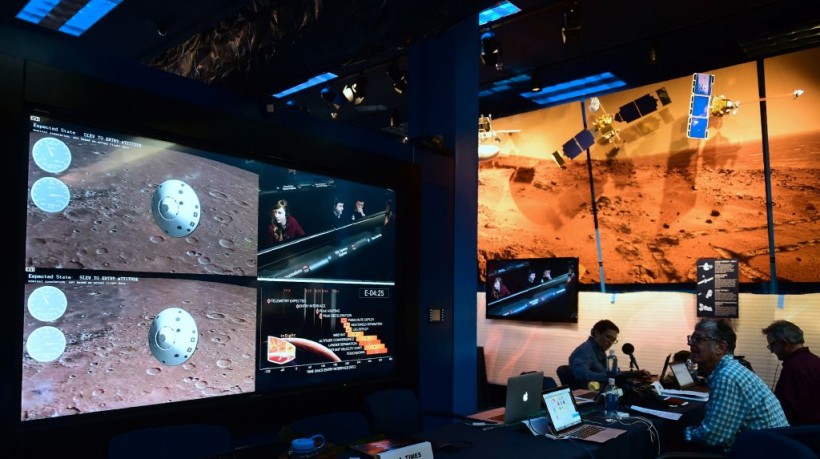For years after giving scientists a thorough look at Mars' interior structure, the world might bid goodbye to NASA's InSight lander but not the Scientists who will take a closer examination of the collected data for future Mars exploration.

(Photo : FREDERIC J. BROWN/AFP via Getty Images)
People watch the landing of NASA's InSight spacecraft on the planet Mars on television screens at NASA's Jet Propulsion Laboratory (JPL) in Pasadena, California on November 26, 2018.
Is InSight Mars lander still active?
NASA's expedition to explore the Martian surface may have succeeded for years, but like any other mission on foreign planets, the Interior Exploration utilizing Seismic Investigations, Geodesy, and Heat Transport, or simply InSight, is destined to retire incrementally this summer.
According to a Tech Times report, NASA's InSight Mars lander will only be giving a farewell to the red-hued planet four years after its touchdown in 2018. However, the data obtained will remain in Earth's database in perpetuity because it aided scientists in their interpretation and understanding of the Martian planet.
In retrospect, the Earth became aware of events that were unique to Mars. InSight also gave NASA scientists more data to analyze for future Mars missions.
Also Read: NASA Announces InSight Lander Has Only a Few More Months Left of Analyzing Martian Surface
What does the InSight lander do?
In an overview of the InSight Mars lander mission, NASA aims to study the internal structure of the planet. In return, providing answers to crucial issues concerning the development of our inner solar system's rocky planets. At the same time, InSight also analyzes tectonic activity and meteorite strikes on Mars.
Now, the Mars lander's mission will finish with a trail of data that will be mined by scientists all across the world for years to come. NASA stated at a media briefing that InSight's four-year presence on Mars would "help increase our knowledge of planet formation," while announcing the conclusion of InSight's science activities.
The legacy at issue was rather large. In an article by Phys org, InSight was equipped with an ultra-sensitive seismometer and detected more than 1,300 "marsquakes," along with a magnitude five quake recorded on May 4, the biggest ever recorded so far.
Aside from that, the seismometer made use of seismic waves that passed through different materials found on Mars and provided a picture of the planet's innards.
Banerdt, who dedicated more than a decade of his life working InSight Mars lander mission, said, "The interior was kind of just a giant question mark but we've been able to map out the inside of Mars for the very first time in history."
From that, scientists were able to establish that Mars' core is and contains liquid. They were also able to measure the thickness of the Martian crust, which was found to be less dense than originally believed and possibly composed of three layers.
However, one baffling discovery made by InSight is that despite thousands of earthquakes, none of them have produced surface waves. The absence of surface waves on Mars might be attributed to severe fracture miles under InSight. It's also possible that the quakes observed by InSight are occurring from deep within the planet, as they would not create powerful surface waves.
After its success, NASA is now exploring adopting the seismometer approach elsewhere in the future. According to Lori Glaze, head of NASA's Planetary Science Division, "We'd really like to set up a complete network on the moon to really understand what's going on there."
Related Article: NASA's InSight Continues Marsquake Hunt Despite Losing Power: Is the Mission Ending?
This article is owned by Tech Times
Written by Thea Felicity









